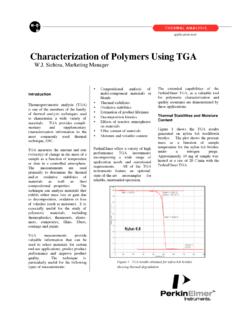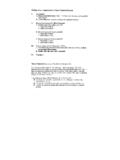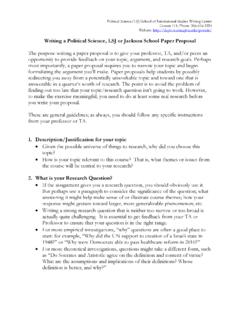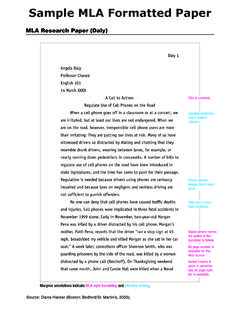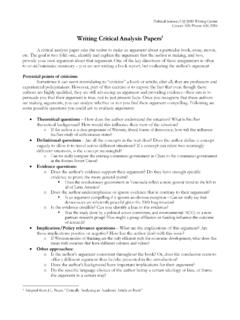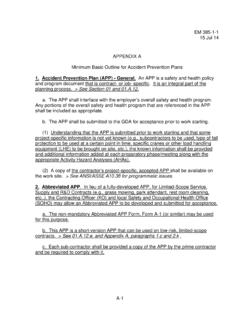Transcription of STANDARD OPERATING PROCEDURE 30-50% HYDROGEN …
1 STANDARD OPERATING PROCEDURE 30-50% HYDROGEN PEROXIDE SOLUTIONP hone number:206-685-3014 Annual Review Date: 10/10/2019 Principal Investigator: Michele Black Room & Building: E-386 Emergency Contact Information: Michele Black I have read and understand the SOP: Name: Signature: Date: Michele Black 10/10/19 Before working with 30-50% HYDROGEN Peroxide, the lab worker must have the approval of the PI who shall provide specific training according to this SOP and in understanding the MSDS provided by the manufacturer.
2 The lab worker must complete UH lab safety training and JABSOM Kaka ako hazardous waste generator training prior to working with any chemicals. The lab worker should sign this SOP as documentation that he/she understands the hazards and has been trained in how to work with high concentrations of HYDROGEN peroxide safely. 1. INFORMATION ABOUT HYDROGEN PEROXIDE AND PROCEDURES USING HYDROGENPEROXIDECAS#7722-84-1 30-50% HYDROGEN Peroxide is a clear, colorless liquid that is classified as a strong oxidizer and acorrosive liquid.
3 It is commonly used as a laboratory reagent and also in its vapor form as a sterilizer, apopular alternative to ethylene oxide and formaldehyde, as a safer and more efficient decontaminationmethod for isolated rooms and biosafety HAZARDOUS PROPERTIES, POTENTIAL ROUTES OF EXPOSURE, SYMPTOMS OF EXPOSURE30-50% HYDROGEN peroxide is an irritant of the eyes, mucous membranes, and of Exposure Skin or eye contact, ingestion or inhalation of the vapor or mist. Acute Effects: The signs and symptoms of acute exposure to HYDROGEN peroxide include irritation of the eyes, nose, throat and lungs, ranging from mild bronchitis to pulmonary edema.
4 Liquid or spray mist may produce tissue damage particularly on mucous membranes of eyes, mouth and respiratory tract. Skin contact may produce burns. Inhalation of the spray mist may produce severe irritation of respiratory tract, characterized by coughing, choking, or shortness of breath. Corneal ulceration, redness and blisters on the skin, and bleaching of hair might occur after contact of the eyes or skin with the liquid or vapor. Ingestion of large doses may cause symptoms of abdominal pain, vomiting, and diarrhea as well as blistering or tissue destruction.
5 Stomach distention (due to rapid liberation of oxygen), and risk of stomach perforation, convulsions, pulmonary edema, coma, possible cerebral edema (fluid on the brain), and death are possible. Chronic Effects: No signs or symptoms of chronic exposure to HYDROGEN peroxide have been reported in humans. Cancer Hazard: Information not available. Reproductive Hazard: Information not available. Exposure Limits: The current OSHA permissible exposure limit (PEL) for HYDROGEN peroxide is 1 ppm ( mg/m3) as an 8-hour time-weighted average (TWA) concentration.
6 The NIOSH recommended exposure limits (RELs) for HYDROGEN peroxide is 1 ppm ( mg/m3) as a TWA for up to a 10-hour workday and a 40-hour workweek. The American Conference of Governmental Industrial Hygienists (ACGIH) assigned HYDROGEN peroxide a threshold limit value (TLV) of 1 ppm ( mg/m3) as a TWA for a normal 8-hour workday and a 40-hour workweek. The NIOSH limit is based on the risk of eye, mucous membrane and skin irritation. The ACGIH limit is based on the risk of irritation. 3. PERSONAL PROTECTIVE EQUIPMENT Use of nitrile, PVC, neoprene or Viton gloves are recommended when handling HYDROGEN peroxide(confirm glove type and use limitations by referring to the JABSOM Glove Compatibility and UseGuide - contact JABSOM EHSO).
7 Safety glasses with side shields, face shield, or chemical splash goggles shall be worn. A chemical-resistant laboratory coat should be worn when working with HYDROGEN peroxide. Closed toe shoes are required when working in the laboratory. Use NIOSH/MSHA approved respirators when vapors or mist concentrations exceed PEL or ifchemical fume hood is not available or accessible. Do not wear or use cotton, wool or leather, as these materials react RAPIDLY with higherconcentrations of HYDROGEN ENGINEERING/VENTILATION CONTROLS Provide exhaust ventilation or other engineering controls to keep the airborne concentrations ofvapors below their respective threshold limit value.
8 Safety shower and eye wash stations should be easily accessible where 30-50% HYDROGEN peroxideis SPECIAL HANDLING PROCEDURES AND STORAGE REQUIREMENTS Store 30-50% HYDROGEN peroxide in a cool, dark, dry, well-ventilated area in tightly sealed and light-resistant containers. Containers of HYDROGEN peroxide should be protected from physical damage. Glass, polyethylene,stainless steel and aluminum are recommended materials for storage containers. Store separately from combustible materials such as wood, paper, oil, etc.
9 , organic materials such asalcohols, acetone, and other ketones; Aldehydes, and their anhydrides; glycerol, cotton (cellulose),metals including iron, copper, chromium, lead, silver, manganese, sodium, potassium, magnesium,nickel, gold, platinum; metal alloys such as brass or bronze; metal oxides such as lead oxides,mercury oxides, or manganese dioxide; and many metal salts, like potassium permanganate orsodium iodate. Tremendous explosion can be caused by unstable mixtures with concentratedmineral acids. Wash hands thoroughly after handling HYDROGEN peroxide (even if gloves were used).
10 Remove contaminated clothing/PPE and wash before reuse. Transport chemicals in closed containers, in the smallest amounts possible, and use aids such ascarts, chemical transport carriers, etc. It is highly recommended that all chemicals be stored below eye level so cracking or leakingcontainers are immediately visible and there is less potential for chemicals falling onto lab workerswhen pulling from PROCEDURES Handling 30-50% HYDROGEN PeroxideoWear appropriate PPE (gloves, eye protection, lab coats).oWork in a well ventilated gloves after handling 30-50% HYDROGEN Peroxide.
